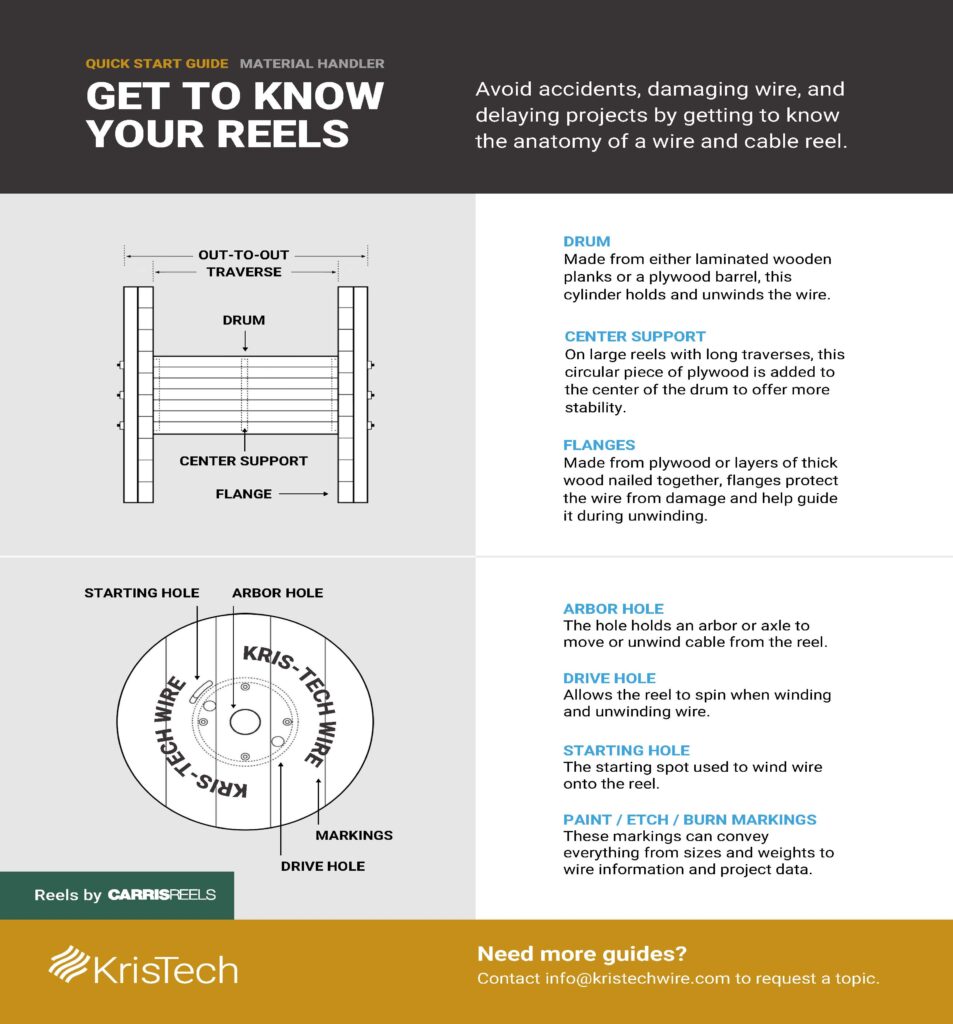It might not look like much at first glance, but the humble wooden wire reel is a job site workhorse.
Sure, the purpose of a wood reel is to hold wire and cable for shipping, unwinding, and convenience. But each piece is carefully designed to safely transport and protect the wire from the factory to its final installation.
Knowing the various parts of a reel and how they work can help support a safer worksite and avoid costly mistakes that could damage wires, slow down installations, or hurt someone.
In the same way every electrician should know each part of a wire or cable, it’s important for workers on the job site handling reels to know what each part is and how it works.
The drum is the cylinder in the middle of the reel that holds the electrical wire.
Generally, this piece is formed using a series of laminated wooden planks called staves or a plywood barrel. To keep the drum’s shape and stabilize its form, plywood disks called drumheads are installed on each end of the drum. If the drum is long, a center support may be used to prevent staves in the middle of the drum from buckling.
“It’s infrequent that a traditional wire and cable reel will have center supports,” Aaron Yaddow with Carris Reels explained. “They’re there, but it’s more frequent when you have a very large traverse, so a large distance between those heads, something longer than 24 or 36 inches. It’s not terribly common unless it’s an inordinately heavy product that goes on top of it, but they are there.”
The length along the drum, or reel’s, inside distance, is called the traverse. To find the traverse, measure from one inner flange to the other. Traverse distance determines how much wire you can safely put on the reel without damaging it but depends on the product wound around it.
A fully loaded reel can be incredibly heavy, but the arbor hole makes hoisting and moving the cable easier.
The arbor hole runs lengthwise through the drum at its center and holds the arbor or axle used to transport or unwind the cable from the reel. Typically, a metal arbor shaft runs through the arbor hole to hoist the loaded reel.
They go by several names, but the flanges are the two large circular discs on either side of the drum.
Generally made of either plywood or layers of thicker wood nailed together, the flanges guide the wire loaded onto the reel. Their large size keeps the wire where it should be during the winding and unwinding processes and protects the cable from damage during transport.
Like how the traverse measures the drum, the out-to-out measurement uses the outside edges of the flanges to see if the reel will fit onto the rigging when the cable needs to be moved or unwound.
“Both the traverse and out-to-out measurements are very important,” Yaddow explained. “The out-to-out measurement is important for the end user because it relates to what kind of equipment they can load the reel onto. If the customer has limitations on their equipment, it’s generally this measurement or the flange diameter that is considered.”
The traverse and out-to-out measurements can also determine load management and ensure the reel sizes match job site specifications, depending on the type of wire or cable used.
Starting holes can be found on the flanges or the drum barrel and are used as a starting point for winding wire onto the reel. Tie-off holes on the flanges hold the wire in place when it isn’t used. Cable slots serve a slightly different purpose, allowing workers to unwind the wire without it catching, binding, or unraveling too quickly.
In every case, each hole is intended to keep the wire where it should be every step of the way.
They might not look beautiful, but the markings on the side of a wire reel can include plenty of helpful data points, including sizes, weights, and other information related to the wire or project.
If the wire is exported, the reel may be marked with a heat-treat stamp to follow international trade regulations.
Note: Every manufacturer is different, so check with your wire provider to see how they mark their reels.
Studying reel anatomy is probably not at the top of most electrical workers’ to-do lists, but knowing parts of a wooden, plastic, or metal reel can save time and effort on the job site.
It often means fewer broken and damaged reels, fewer employee accidents, and better installations because the wire is protected from damage.
Take a moment to educate yourself and those around you. With basic knowledge, you can create a safer, more efficient worksite.
